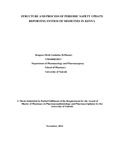| dc.description.abstract | A Periodic Safety Update Report (PSUR) is a mechanism by which a company may summarise and evaluate medicinal products safety data for a particular interval time in a standardised manner for submission to medicines regulatory authorities. During medicine development, only a limited number of patients are included in the clinical trials. However, once the product is submitted for market approval, its efficacy and evaluation for safety is based on thousands of patients. Therefore, detection of rare adverse reactions is difficult and hence need for Periodic Safety Update reporting.
Objective: To assess the structure, content and process of Periodic Safety Update reporting of medicines in Kenya.
Methodology: A cross-sectional study of documentary materials and structured key informants interviews at the Pharmacy and Poisons Board (PPB), Kenya.
Results: Most (68.8%) of the PSURs did not include a cover letter which is an essential component of PSUR. For most of the reviewed PSURs, the medicinal products (93.8%) had not experienced any change to the marketing authorization status, and none had any actions taken for any safety reasons. Nearly all the PSURs (96.9%) had used Company Core Data Sheet( CCDS ) as the reference document and most of them between 56.3 to 96.9%, did not have any sections of the reference safety document changed. Of all PSURs submitted, 50% used defined daily doses as a methodology for exposure number calculations. Only 21.8% of the PSURs had targeted new studies and 71.9% had published studies. Majority of the PSURs (87.5%) did not have a risk management plan neither did 71.9% have risk benefit analysis report.
PSURs considerably differed in presentation of overall safety evaluation. At least, 65.6% reported medication error, 62.5% reported abuse or misuse, 59.4% reported drug interactions, and 56.3% reported off-label use. At least, 50% of the PSURs had potential safety concerns. With regard to the organizational structure of reporting system, the Pharmacy and Poisons Board (PPB) PSUR review committee, was composed of four pharmacists, two pharmaceutical technologists and two clerical staff. The Department is fully computerized with reliable internet connection. Critical information by any submitting Marketing Authorization Holder (MAH) is sent within 48hours. In regard to process, the MAH submits two hard copies of the PSURs alongside a softy copy,a cover letter is signed and one is retained at the department while the other goes back to the MAH. This is coded and entered into an excel sheet awaiting review. However, there are no scheduled dates for review
Conclusion
The Pharmacy and Poisons Board had a well laid down structure for Periodic Safety Update reporting, however there was need for a harmonized format for capturing information and a mandatory requirement for MAHs to timely submit the PSURs. In addition, a policy to be put in place with additional staff and government to allocate funds to facilitate regular reviews. | en_US |
| dc.description.department | a
Department of Psychiatry, University of Nairobi, ; bDepartment of Mental Health, School of Medicine,
Moi University, Eldoret, Kenya | |

